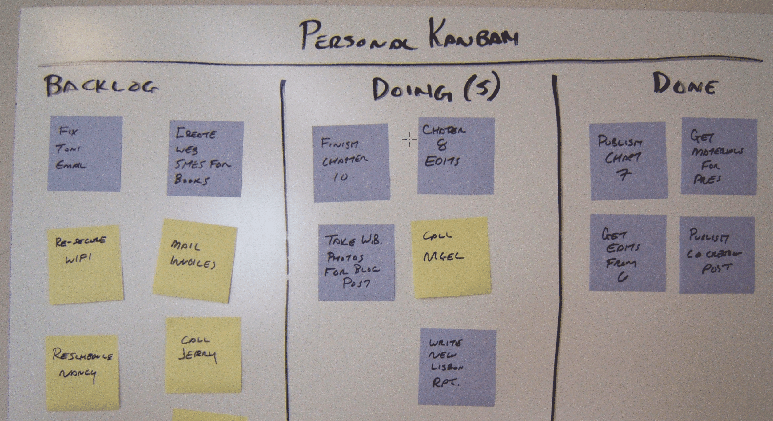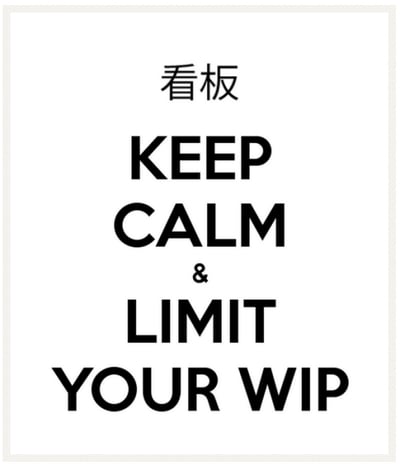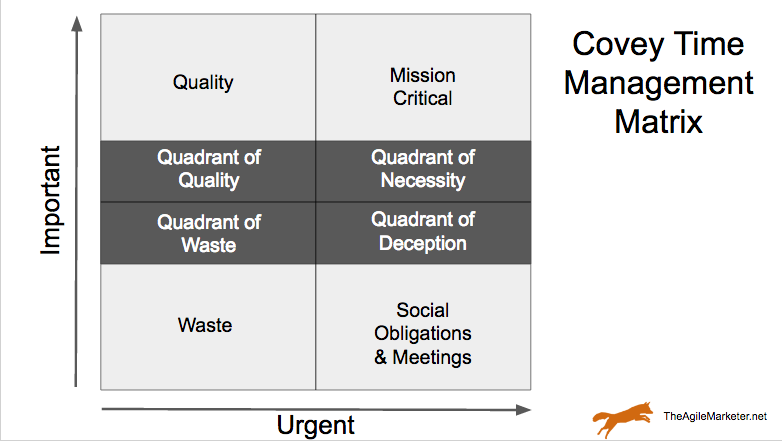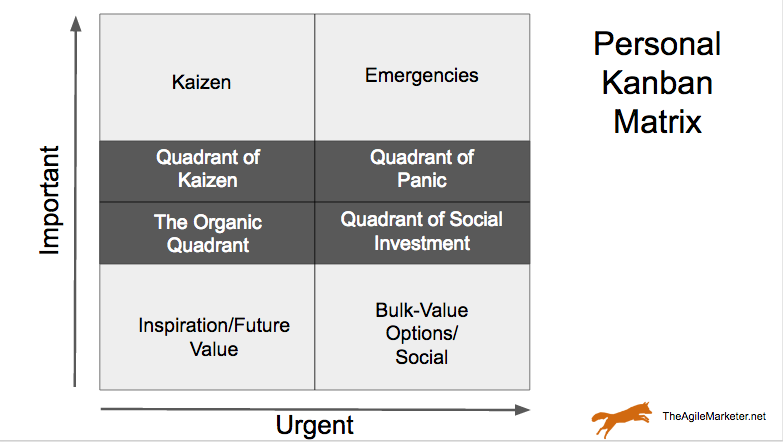Have you ever crossed off the last item on your to-do list, only to realize that you haven’t really accomplished anything?
It happens all the time, because to-do lists are terrible personal productivity tools.
They’re nothing but a mindless, meaningless litany of stuff taken out of context and shoved into a day.
Fortunately, there’s a better way to manage work.
Whether you’re a freelancer or a solopreneur who works independently, or a member of a traditional team looking to get more out of your workday, Agile can help.
You’ve probably heard about Scrum teams or Agile teams, but the reality is that individuals can get all the benefits of Agility, even if they’re on their own .
By shifting your focus from mindless productivity to reasoned effectiveness, personal Agility lets you broaden your perspective.
It allows you to look around, take stock, and regularly reevaluate what you’re doing.
This not only reduces your stress and improves the quality of your work, it creates space in your day for you to discover the value and meaning of your work, which are the first things to get lost when you’re racing from one emergency to another.
Instead of grinding out your days living from vacation to vacation, take a chance on personal Agility and banish your to-do list forever.
2 Rules of Personal Kanban
Your personal Agility journey is likely to meander through multiple methodologies, but I strongly suggest you start out by using Personal Kanban.
Pioneered by Jim Benson and Tonianne DeMaria Barry, this lightweight, simple system reduces the barriers to entry for beginners, but also provides plenty of high-powered options for advanced practitioners.
Personal Kanban has only two rules: visualize your Backlog and limit your Work-in-Progress (WIP).
Within these two rules lies unlimited variety, because each individual’s implementation will take a different form. At its simplest, a Personal Kanban board has just three columns:
Backlog → Doing → Done

When you have room in your In Progress column, you pull new work from your Backlog and begin working on it. Once it’s finished, you move it into the Done column.
You can experiment with adding two additional columns: Today and The Pen.
Today is simply the tasks you plan to complete today. The Pen holds work that is waiting on outside input before it can be worked on or designated as complete.
It’s simple in theory, but more complex in reality.
Here’s how we get there.
Rule 1: Visualize Your Backlog
If you have limited physical space, say in a cubicle or a tiny home office, you can have a digital backlog and a physical board for your current tasks. But, whatever scenario works for you, make sure you get all of your outstanding work out of your head and into some kind of visual format.
It’s vital that you devote considerable time and mental energy to this part.
All the “stuff” that you need to do distracts you constantly. Known as the “Zeigarnik Effect,” this phenomenon states that adults have a 90% chance of remembering thoughts or actions that were interrupted over those that were completed.
As Jim and Tonianne point out, this means that “Unfinished tasks vie for our attention, causing intrusive thoughts that ultimately impeded productivity and increase the opportunity for error.”
But if you can visualize what you’ve got to do, it becomes a known, manageable entity.
Visualization also allows us to learn how our tasks are interrelated, batch similar tasks efficiently, and prioritize effectively.
If you’re a one-person show, I suggest expanding your backlog’s contents to include everything that impacts your day. If you include workouts, dropping the kids off at soccer, and scheduling the plumber alongside your professional obligations, you’ll give yourself the opportunity to develop an understanding of the tradeoffs and cause-effect relationships in your world that are currently unknown.
For agilists working this system in a more traditional professional environment, you may want to limit your backlog to work-related tasks unless there are outside factors that impact your working time.
Rule 2: Limit Your WIP
We work most effectively when we approach our work in a linear fashion, completing one thing before moving on to the next. Multitasking is a myth.
Our brains crave closure and completion, and they get stressed when we’ve got too much going on.
That means we need to put a tight limit on our personal work in progress, something in the neighborhood of 2-3. But keep in mind that people aren’t nearly as predictable as organizations, so your WIP may vary situationally.
We’ll touch on this more later in the article, but don’t let your Personal Kanban system become so rigid that it becomes a hindrance instead of a help.
Allow yourself to experiment with your WIP limit. Just don’t let it get so high that you’re depriving your brain of its much-needed completion fix.
Why Agility? Trading Productivity for Effectiveness (Most of the Time)
Productivity is only concerned with one thing: how much you can get done in a certain amount of time.
But was it the right work?
Did you do it well?
Did you enjoy doing it?
Will you have to do it again?
None of these criteria factor into a system that’s driven solely on being productive.
Effectiveness, on the other hand, is doing the right work at the right time.
If I write ten blog posts this week, I’ll feel very productive. But if all that writing time means that I don’t get my slides designed for next week’s webinar, I’ll be stressed and likely to produce sub-par work.
It would have been far more effective for me to finish the webinar slides early in the week and then work on blog posts. My total output might have been lower in terms of quantity, but my the value I created through my work would have increased dramatically.
Of course, there are going to be times when you need to crank some work out, in which case you can adjust your system accordingly.
As Jim and Tonianne remind us, “Doing the right work at the right time requires us to optimize for the situation, to always be adaptable. If productivity is called for, optimize for productivity. If efficiency or effectiveness are called for optimize accordingly.”
Implementing Pull Systems in a Push Environment
Most professional offices are push-driven environments. Your boss and colleagues push work onto you, you try to complete it, and in the meantime more work comes your way.
If you’re lucky you’ve only got a couple of push sources; if you’re unlucky, work comes at you like an avalanche.
Personal Kanban and other Agile systems, on the other hand, are pull-based. This means that you choose to pull the right work at the right time, rather than jump on the most recent thing that has been thrown into your path.
To effectively get a pull system going in a push environment, we’ve got to learn to work what’s known as the Time Management Matrix.
Working the Time Management Matrix
Popularized by Stephen Covey, this approach attempts to highlight the relative urgency and importance of the tasks facing us:
Personal Kanban makes a couple of changes to how this tool works:
The top right quadrant is now the Quadrant of Panic, and we don’t want to spend our time here. “Routinely responding to emergencies begets more emergencies,” says Personal Kanban, and it’s not a happy place to live.
Work pushed onto you is likely to fall into this quadrant; get it done and get it out as quickly as you can.
Your focus should be on the Important But Not Urgent Quadrant, now known as The Quadrant of Kaizen (a concept which we’ll cover shortly). Work on your core job duties probably falls here, and you should spent as much time as possible on those tasks.
Additionally, devoting time to tasks that fall here saves you from future panic because you complete them before they become urgent.
Tasks that are urgent but not important, like telephone calls and meetings, Covey calls deceptive tasks. They appear to be productive, but they are actually a waste of our time.
Personal Kanban, however, doesn’t classify all urgent and unimportant tasks this way.
Instead this is now The Quadrant of Social Investment. Who knows how valuable a meeting or phone call may prove itself to be in the future? Six months later it may turn into a brand new partnership or job opportunity. Don’t assume that everything here is a wasteful activity.
Finally, the not urgent and not important quadrant. For Covey, tasks that fall here are pleasant activities that provide little value and distract us from true productivity. Your Personal Kanban approach, however, calls this The Organic Quadrant.
It’s your life, and only you know what’s truly wasteful. Spending time cultivating relationships on social media could be wasteful, or it could be deeply meaningful. You decide.
When work is pushed on you, evaluate it and choose which of these four quadrants it falls into.
If it’s not in The Quadrant of Panic, chance are you can put in your backlog and incorporate it into your own flow at the right time. That’s the best case scenario; there will inevitably be times when you can’t respectfully postpone an externally imposed task.
When that happens, don’t sweat it.
“Pull when you can, be pushed when you must. Don’t become so enamored with the form of your Personal Kanban that you can’t adapt to changing realities,” Jim and Tonianne exhort. “Find the best visualization and working style to deal with overwhelming work in the moment.”
The Power of the Kaizen Mindset
Kaizen sounds like some sort of martial art, but it’s in reality it’s simply a commitment to continuous improvement.
When something isn’t working, you don’t ignore it or work around it, you try to make it better.
Kaizen may happen during a designated retrospective, when you sit down and reflect on how your week went, or it may be a spontaneous moment of revelation.
Either way, you’ve identified an opportunity to make your day better in the future, and that’s a huge win.
Next Steps
If you’re ready to ditch productivity and focus on becoming more effective, I highly recommend giving Personal Kanban a quick read. You can get through it in a few hours, and it’s full of far more detailed guidance than I can give you in a 1,600-word article.
Then let me know how your own journey towards greater agility is going!







